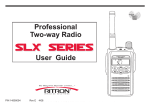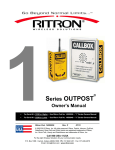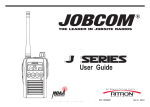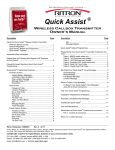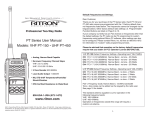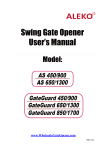Download Ritron RQT-452-RCVR Owner`s manual
Transcript
RQT-xxx-RCVR Owner’s Manual Quick Talk TM Wireless Voice Monitor & Alarm transmitter with factory installed 433.92 MHz Keyfob Receiver RQT-151-RCVR RQT-151M-RCVR RQT-451-RCVR RQT-152-RCVR RQT-152M-RCVR RQT-452-RCVR Call 800-USA-1-USA for the right Wireless Solutions to your communication needs. Ritron, Inc. P.O. Box 1998 • Carmel, Indiana 46082-1998 • USA Phone: 317-846-1201; 800-USA-1-USA (800-872-1872) Fax: 317-846-4978 Email: [email protected] Ritron Publication 14500082 RQT-433-RCVR FACTORY INSTALLED ONLY Rev. A 02-12 © 2012 Ritron, Inc. All rights reserved. Ritron, Patriot, Jobcom, OutPost, GateGuard, Quiet Call and Quick Assist are registered trademarks of Ritron, Inc. Quick Talk, Liberty and RadioNexus are trademarks of Ritron, Inc. For assistance, call RITRON at 800-872-1872, or go to www.ritron.com 1 Table of Content RQT-433-RCVR FCC Part 15 Statement RQT Models and Keyfobs ............................................. 2 RQT-433-RCVR FCC Part 15 Statement ..................... 2 General Information ...................................................... 3 RQT Radio Operation ................................................... 3 Effect on RQT Radio Battery Life.................................. 3 RQT-KEYFOB Operation .............................................. 4 RQT-KEYFOB Battery Replacement ............................ 4 RQT-KEYFOB FCC Part 15 Instructions ...................... 5 RQT Radio Programming.............................................. 6 Programmable RQT Radio Attributes ........................... 7 Changing the Address................................................... 8 Specifications ................................................................ 9 This device complies with part 15 of the FCC Rules. RQT Models and Keyfobs Ritron RQT Models with the RQT-433-RCVR installed: RQT-151-RCVR RQT-152-RCVR RQT-151M-RCVR RQT-152M-RCVR Ritron Keyfob Transmitters: RQT-KEYFOB-1 RQT-KEYFOB-3 RQT-KEYFOB-2 RQT-KEYFOB-4 RQT-451-RCVR RQT-452-RCVR Operation is subject to the following two conditions: (1) This device may not cause harmful interference, and (2) This device must accept any interference received, including interference that may cause undesired operation. This equipment has been tested and found to comply with the limits for a Class B digital device, pursuant to Part 15 of the FCC Rules. These limits are designed to provide reasonable protection against harmful interference in a residential installation. This equipment generates, uses and can radiate radio frequency energy and, if not installed and used in accordance with the instructions, may cause harmful interference to radio communications. However, there is no guarantee that interference will not occur in a particular installation. You can test to see if this equipment does cause harmful interference to radio or television reception by turning the equipment off and on. Caution: Changes or modifications not expressly approved by the party responsible for compliance could void the user's authority to operate the equipment. For assistance, call RITRON at 800-872-1872, or go to www.ritron.com 2 General Information The RQT-433-RCVR is a 433.92 MHz keyfob receiver designed for use with the Ritron RQT Series transmitter. When installed, the RQT-433-RCVR allows the user to activate RQT pre-recorded messages by pressing a small keyfob transmitter. Ritron model keyfobs are preset to activate 1 of 8 RQT messages. Simply record your desired voice message into the RQT Series transmitter using the RQT PC Programmer and you are ready to go. RQT Radio Operation For RQT models with an RQT-433-RCVR installed, any of the 4 RQT inputs can be programmed for “KEYFOB” operation. This will allow that input to operate on 2 preassigned Ritron keyfobs per the following chart: Programming section of this manual for details of KEYFOB input programming and the associated programming options available. Once the radio has been programmed and installed, Ritron model keyfobs can be used to activate the RQT transmitter and broadcast a unique, user recorded voice message associated with the specific keyfob. EXAMPLE: RQT Input 1 is set for “KEYFOB” operation with “Assistance needed in classroom 111” recorded for RQT-KEYFOB-1 and “Assistance needed in classroom 112” recorded for RQT-KEYFOB-2. Ritron keyfobs RQT-KEYFOB-1 and RQT-KEYFOB-2 can now activate these two recorded messages respectively. Effect on RQT Radio Battery Life RQT Input Pre-assigned Keyfob Models Input 1 Input 2 Input 3 Input 4 RQT-KEYFOB-1 RQT-KEYFOB-3 RQT-KEYFOB-5 RQT-KEYFOB-7 RQT-KEYFOB-2 RQT-KEYFOB-4 RQT-KEYFOB-6 RQT-KEYFOB-8 Once an RQT input is set for “KEYFOB” operation it will no longer respond to switch closures or analog signals, the two input messages can only be activated by the two keyfobs assigned to that input. Refer to the RQT In order for the RQT-433-RCVR receiver to reliably decode signals from the keyfob transmitters, RQT radio models with the RQT-433-RCVR keyfob receiver installed have increased current requirements and do not operate in the low current “standby” mode. Therefore, battery life is severely reduced and it is recommended that the RQT be externally powered. Where battery life of an RQT radio would normally be about 1 year, it drops to about 2 weeks with the RQT433-RCVR installed. For assistance, call RITRON at 800-872-1872, or go to www.ritron.com 3 RQT-KEYFOB Operation RQT-KEYFOB Battery Replacement When operating a keyfob transmitter the best performance is achieved with the keyfob held between the thumb and forefinger, with the top of the keyfob uncovered and vertical (as shown). The keyfob utilizes a standard CR2032 lithium button cell. In normal use, it can provide up to 1 year of operation. IDEAL It is important to understand that only one keyfob transmitter at a time can be activated within a reception area. While the transmitted signal consists of encoded digital data, only one carrier of any particular frequency can occupy airspace without contention at any given time. If two transmitters are activated in the same area at the same time, then the signals will interfere with each other and the decoder will not see a valid transmission, so it will not take any action. The effective range of a Ritron keyfob is similar to that of a garage door opener. Range will be affected by building structures, topography, how the keyfob is held, or if the keyfob is in your pocket while attempting to press the button. Access for replacement is accomplished by gently prying apart the two halves of the keyfob at the seam (fingernails will do for this). Once the unit is open, remove the battery by sliding it out the bottom the retainer. RQT-KEYFOB1 There may be the risk of explosion if the battery is replaced by the wrong type. Replace it with the same type CR2032 lithium button cell battery by sliding it into the bottom of the retainer with the printed “+” side facing up as shown. The location of the RQT transmitter can help extend the range of the RQT-433-RCVR. For assistance, call RITRON at 800-872-1872, or go to www.ritron.com 4 RQT-KEYFOB FCC Part 15 Instructions This device complies with Part 15 of the FCC Rules. Operation of this device is subject to the following two conditions: (1) This device may not cause harmful interference, and (2) This device must accept any interference received, including interference that may cause undesired operation. This equipment has been tested and found to comply with the limits for a Class B digital device, pursuant to Part 15 of the FCC Rules. These limits are designed to provide reasonable protection against harmful interference in a residential installation. This equipment generates, uses and can radiate radio frequency energy and, if not installed and used in accordance with the instructions, may cause harmful interference to radio communications. • Increase the separation between the equipment and receiver. • Connect the equipment into an outlet on a circuit different from that to which the receiver is connected. • Consult the dealer or an experienced radio/TV technician for help. This equipment has been certified to comply with the limits for a Class B computing device, pursuant to FCC Rules. In order to maintain compliance with FCC regulations, shielded cables must be used with this equipment. Operation with non-approved equipment or unshielded cables is likely to result in interference to radio and TV reception. The user is cautioned that changes and modifications made to the equipment without the approval of manufacturer could void the user’s authority to operate this equipment. However, there is no guarantee that interference will not occur in a particular installation. If this equipment does cause harmful interference to radio or television reception, which can be determined by turning the equipment off and on, the user is encouraged to try to correct the interference by one or more of the following measures: • Reorient or relocate the receiving antenna. For assistance, call RITRON at 800-872-1872, or go to www.ritron.com 5 RQT Radio Programming Ritron Models with the RQT-433-RCVR installed: Programming an RQT transmitter (equipped with the RQT-433-RCVR) for keyfob operation requires Ritron PC Programmer RQT-PCPS or RQT-BASIC-PCPS revision 1.1.0 or higher. A programmer update to this revision is available at www.ritron.com/tech. RQT-151-RCVR RQT-151M-RCVR RQT-451-RCVR RQT-152-RCVR RQT-152M-RCVR RQT-452-RCVR 2. Select the input you would like to program for Keyfob operation. The input you select will depend on the specific Ritron keyfobs you use. Check to see which model keyfob you have and program the input per the following list. Input Models Input 1 Input 2 Input 3 Input 4 RQT-KEYFOB-1 RQT-KEYFOB-3 RQT-KEYFOB-5 RQT-KEYFOB-7 RQT-KEYFOB-2 RQT-KEYFOB-4 RQT-KEYFOB-6 RQT-KEYFOB-8 3. From the left column of Input programming screen, set the Input Type to Keyfob. 4. Press the Record button and record a unique message for the Ritron keyfob indicated. Repeat the process if a second keyfob is to be used. 1. Connect the RQT radio to your computer via the USB port and using the Ritron PC Programmer, read out the radio programming. If the model indicated is not on the following list, your radio is not equipped with the RQT-433-RCVR keyfob receiver and cannot be programmed for keyfob operation. 5. Program the various attributes available on the Input programming screen to customize how the RQT transmitter will respond to the keyfob. For assistance, call RITRON at 800-872-1872, or go to www.ritron.com 6 Programmable RQT Radio Attributes Latch On - When Latch On is selected, the RQT will ignore decoded signals from the keyfob until after the transmission schedule has been completed. If not set, the RQT will transmit the recorded message every time it receives the correct code. EXAMPLE: RQT-KEYFOB-1 is scheduled for 2 transmissions, 30 seconds between transmissions. When RQTKEYFOB-1 has been decoded the recorded message will be transmitted twice with 30 seconds in between, and any additional signals from RQT-KEYFOB-1 will be ignored until 30 seconds after the message is sent the 2nd time. Signals from other keyfobs will still be heard, only RQT-KEYFOB-1 will be ignored. Input Operation - can be set for 1 of 3 different modes: Normal operation considers the RQT-KEYFOB code as it is received. Dwell operation requires the keyfob code to be present continuously for a specified period of time before considering. Holdoff operation considers the keyfob code as it is first received, but will ignore additional signals from the keyfob for the programmed holdoff time. EXAMPLE: RQT-KEYFOB-2 set for 1 min. holdoff. When the RQT-KEYFOB-2 code is received the recorded message will play. Any additional signals from RQTKEYFOB-2 will be ignored until after 1 minute has elapsed. Number of Message Transmissions - specifies the number of times a recorded message will be transmitted after an RQT-KEYFOB code has been received. Time between Transmissions specifies the length of time between scheduled transmissions. If it is set to “No Message”, the recoded message will not play. If it is set to “On Changes Only”, the recorded message will only play when the keyfob code is decoded. Play Message on each Transmission specifies the number of times the recorded message will be repeated on each transmission. EXAMPLE: RQT-KEYFOB-1 is scheduled for 2 transmissions, 30 seconds between transmissions, 2 messages per transmission. When RQT-KEYFOB-1 has been decoded the recorded message will be transmitted twice, wait 30 seconds, then the message is transmitted twice again. For assistance, call RITRON at 800-872-1872, or go to www.ritron.com 7 Changing the Address For convenience, the RQT-433-RCVR keyfob receiver and all Ritron keyfobs come from the factory set to the same address. This establishes a relationship between a single RQT-433-RCVR receiver and multiple keyfobs with different codes. For the vast majority of users the address does not need to be changed. Occasionally the user may want to change the address to: • Install two or more RQT-433-RCVR keyfob receivers in the same location. • Avoid interference with another transmitter using the same address. • Create a more secure “non-standard” address. Address lines The RQT-433-RCVR receiver and RQT-KEYFOB transmitters allow the selection of one of 1,024 unique addresses. To avoid contention with other units or to create unique relationships, the address can be changed. This is accomplished by cutting PCB traces with a sharp object, such as an X-Acto knife. RQT-KEYFOB On the RQT-KEYFOB keyfob the traces are accessed by removing the rear cover. If the trace is intact, the address line is connected to ground, otherwise it is floating. The RQT-433-RCVR receiver address must match exactly in order for the units to communicate. EXAMPLE: Both the RQT-KEYFOB and the RQT-433-RCVR can be programmed with the same unique address by cutting the PCB traces at positions 2 and 4. They now have a unique relationship that allows them to communicate only with each other. Address lines RQT-433-RCVR For assistance, call RITRON at 800-872-1872, or go to www.ritron.com 8 Specifications RQT-433-RCVR RQT-KEYFOB Receive Frequency Center Frequency Accuracy Sensitivity Modulation Type Antenna FCC Part FCC ID Input Voltage Operating Voltage Input and Output Logic Interconnection Current - Standby Current – w/Antenna Disable Temperature 433.92 MHz +/- 50 kHz -112dBm typical OOK Helical wound ¼ wave 15B AIERIT32-433-RCVR 6-12 VDC 5.0 VDC 0-5 VDC +V in Ground Valid Decode Out Clock In Antenna Disable In Data Out 5.9 mA 14.1 mA -30°C to +60°C Transmit Frequency Center Frequency Accuracy Radiated Power Modulation Type Antenna FCC Part FCC ID Operating Voltage Battery 433.92 MHz +/- 50 kHz < 200µV/m per FCC Part 15.209 OOK Loop trace 15C, 15.231 OJM-CMD-KEYX-XXXA 3V CR2032 Lithium cell For assistance, call RITRON at 800-872-1872, or go to www.ritron.com 9









